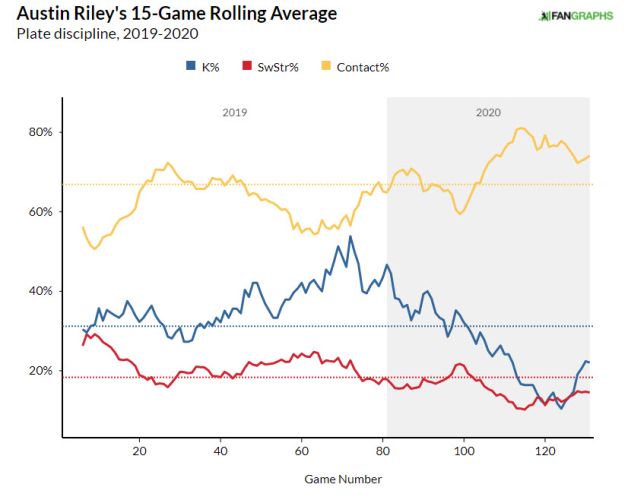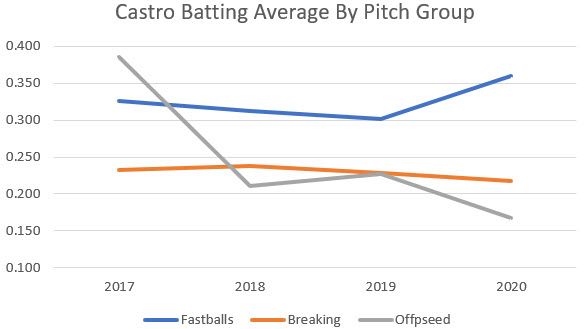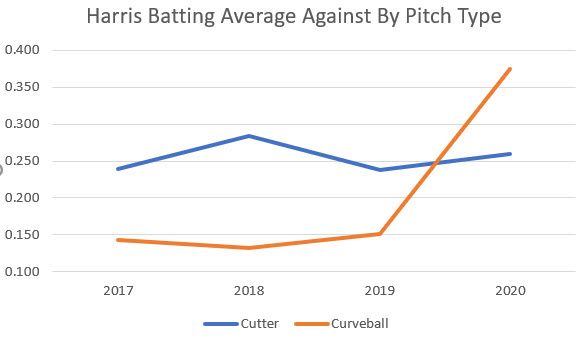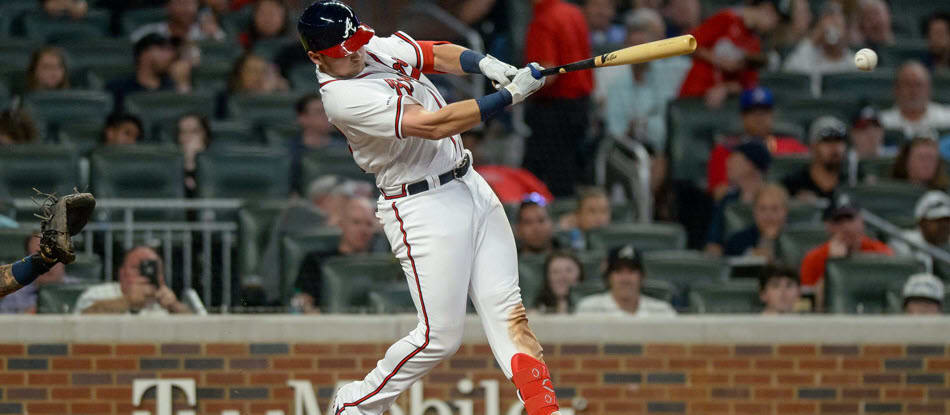This article is part of our Collette Calls series.
It's time, once again, to put myself out there and make 60 predictions for the new season. The premise for this annual article series remains the same: the prediction has to be somewhat grounded in reality but at the same time viewed as unlikely when you first read it. So, you will not find me predicting Ryan Yarbrough to win the Cy Young, but you may see me making calls predicting a breakout for Corbin Burnes as I did in this series just last year. Conversely, you will find some big misses such as me laying out the case why Shane Bieber would not finish the season as a top-20 starting pitcher.
When you play in the margins with predictions, you are going to lose more than you will win. The last three seasons, I've hit on 21 to 24 of the 60 predictions I've made with some rather big hits (Renato Nunez, Blake Snell, Lance Lynn, Jose Abreu) and many more misses. Just last year, this series helped identify the upside of taking a chance on A.J. Pollock, Andrew McCutchen, Asdrubal Cabrera, Ian Happ, Marcell Ozuna, Trent Grisham, Chris Bassitt, the aforementioned Burnes, Tony Gonsolin, and Justus Sheffield.
While I strive for higher rates of accuracy, you will not see me lower the credentials for predictions to increase the chances of the prediction coming true. My goal is not to go 60 for 60 on
It's time, once again, to put myself out there and make 60 predictions for the new season. The premise for this annual article series remains the same: the prediction has to be somewhat grounded in reality but at the same time viewed as unlikely when you first read it. So, you will not find me predicting Ryan Yarbrough to win the Cy Young, but you may see me making calls predicting a breakout for Corbin Burnes as I did in this series just last year. Conversely, you will find some big misses such as me laying out the case why Shane Bieber would not finish the season as a top-20 starting pitcher.
When you play in the margins with predictions, you are going to lose more than you will win. The last three seasons, I've hit on 21 to 24 of the 60 predictions I've made with some rather big hits (Renato Nunez, Blake Snell, Lance Lynn, Jose Abreu) and many more misses. Just last year, this series helped identify the upside of taking a chance on A.J. Pollock, Andrew McCutchen, Asdrubal Cabrera, Ian Happ, Marcell Ozuna, Trent Grisham, Chris Bassitt, the aforementioned Burnes, Tony Gonsolin, and Justus Sheffield.
While I strive for higher rates of accuracy, you will not see me lower the credentials for predictions to increase the chances of the prediction coming true. My goal is not to go 60 for 60 on these; it is to get you thinking differently about each one of these players. Statistical predictions in player capsules or writeups are, at best, within the range of accuracy 70 percent of the time. My purpose is to get you thinking about what could potentially happen in the other 30 percent of the pie.
The small sample of 2020 compounded with all of the related factors in prepping for and playing through a season during a pandemic loom large in the statistics, which is why you'll see a focus on timelines rather than solely focusing on the previous season.
ADP is from NFBC from 204 drafts over the last 60 days.
Atlanta
Austin Riley (ADP 210; high 152, low 394) is a top-150 player. Riley is the 22nd third baseman off the board, going just behind Josh Donaldson and just ahead of the recently re-signed Justin Turner. A jump into the top 150 would only push him up into the top 17 of current third baseman ADP, as the position has depth this year given DJ LeMahieu, Cavan Biggio, Jeff McNeil, Max Muncy, Alec Bohm and Tommy Edman have multi-positional eligibility that includes the hot corner.
Riley enters the 2021 season as the everyday third baseman in his third season in the big leagues. He made improvements in both his walk rate and his strikeout rate last season, but his outputs to date have not matched the projected level of his performance as he made his way up the minor league ladder. The projections came from Riley's ability to barrel a baseball, and trust me when I tell you that you know when it is him at the plate in a AFL game. The problem has been the empty swings, particularly against righties as he has a .225/.277/.407 line against them with a 30 percent strikeout rate in less than 400 plate appearances. The numbers are better against lefties (.255/.325/.585), but he strikes out even more against them, which is somewhat offset by a double-digit walk rate.
I'm buoyed by the fact that Riley showed improvement as the 2020 season went on and things are trending in a positive direction for him:

The fewer empty swings, the more opportunities for his potent bat to drive the baseball. He is slated to hit seventh in the lineup, but could push his way higher if he breaks out. The Atlanta lineup is deep, so Riley should have ample RBI opportunities from the seven spot, though the lack of a DH would mean fewer runs as pitchers will opt to pitch around the eighth spot to watch pitchers fail to hit.
Ian Anderson (ADP 99; high 62, low 146) is not a top-150 player. This pick has nothing to do with Anderson's low spin rates (bottom 10th percentile on FB and CB), or any kind of statement that his success was fueled by luck and that he is headed for as sophomore slump. He, in fact, fits the contact-suppressing profile I have been intrigued by all offseason as he moves his three offerings up and down the zone with strong command and was fun to watch pitch in 2020. His expected stats were in the top 10th percentile across the board, and if this were a different pitcher, I would perhaps be pushing Anderson in the other direction.
My reason for fading Anderson is I am concerned he will not pitch enough in 2021 to meet expectations. Anderson turns 23 in early May, and he threw 51 innings in 2020 between the regular season and postseason. That workload was coming off him working 134.2 innings in 2019 between Double-A and Triple-A. Given his age and career upside, I just do not see Atlanta allowing Anderson to absorb a high workload in 2021. The immediate counter-argument to my stance is Mike Soroka, who pitched 56.1 innings in 2018 as a 20-year-old, then threw 174.2 innings the following year before his 2020 season was disrupted by tearing his Achilles in his third start of the season. The organization is clearly comfortable with it, but it's also been deliberate with Anderson's workload in his development:
- 2016 - 39.2 IP
- 2017 - 83 IP (112 percent increase YoY)
- 2018 - 119.1 IP (44 percent increase YoY)
- 2019 - 134.2 IP (13 percent increase YoY)
Even if we took his 2019 innings level as a 2021 prediction, it would represent a 164 percent increase in his year-over-year workload. That is still smaller than the 210 percent increase Soroka had from 2018 to 2019, but Soroka had also worked in 143 and 153.2 innings the season before with his effortless delivery.
Pitchers going after Anderson who have a safer pathway to high workloads include Zack Greinke (ADP 110), Charlie Morton (ADP 122), Lance McCullers (ADP 122), Pablo Lopez (ADP 127) and Joe Musgrove (ADP 129.) For the sake of the sport, I want to be wrong here and hope that Anderson continues to pitch to the levels he showed in 2020, but I do think Atlanta and others are going to exercise caution this year and not push their younger pitchers to previous workloads.
Miami
Adam Duvall (ADP 418; high 232, low 562) is a top-60 outfielder. Duvall is currently the 99th outfielder by ADP, coming just after recently acquired Franchy Cordero and just before recently marginalized Michael Chavis. Readers of this series will recall I boldly predicted a 30-homer season from Duvall in 2019, and he in fact did so, albeit with 32 of those 42 homers coming for the Gwinnett Strippers in Triple-A. He followed that 42-homer season with 16 as a full-time player in 2020, albeit with a low batting average and OBP. Duvall has always been this guy at the big-league level, but the 2018 season was such a struggle he had to go back to Triple-A to re-establish himself as a big-league hitter. Now, he is projected to hit in the middle of the Miami lineup as the everyday right fielder.
Our projections for Duvall are the loftiest of the ones that are freely available, as others have not truly accounted for Duvall's new full-time role and his spot in the lineup:
| System | AVG | HR | RBI | R | SB |
|---|---|---|---|---|---|
| RotoWire | .237 | 30 | 76 | 72 | 1 |
| Steamer | .228 | 23 | 64 | 56 | 2 |
| ZiPS | .228 | 28 | 91 | 64 | 2 |
| ATC | .231 | 23 | 60 | 52 | 1 |
| The BAT | .221 | 23 | 65 | 54 | 1 |
Moving to Miami is going to slightly impact the homer total, along with the reported changes to the baseball. Thirty homers will be tough to repeat, but Duvall is not short on power and should have every opportunity to play throughout the season giving him enough opportunities to reach for 30. The batting average will be a risk, but Duvall is now going to see the most consistent playing time he has seen since 2016-17 when he hit in the middle of the Cincinnati lineup with solid run production. He has the opportunity to do that once again after re-establishing himself in Atlanta.
Elieser Hernandez (ADP 249; high 175, low 333) is a top-60 pitcher. Hernandez is the 95th pitcher off the board, just behind the recovering Chris Sale and the potential closer in Will Smith. Hernandez is running a distant fourth by ADP in his own organization as Pablo Lopez (126), Sixto Sanchez (133) and Sandy Alcantara (138) are all well ahead of him with good reason. Each has already demonstrated solid production or solid skills whereas Hernandez has demonstrated upside with a serious side order of gopheritis.
Hernandez has pitched 173.2 innings in the big leagues the last three seasons and has a career 1.9 HR/9 rate and yet has kept his career ERA to less than 5.00 because he has grown ever-stingy with his walks. Last season, he was pitching relatively effective baseball with a 3.16 ERA in six starts along with a stellar 27 percent K-BB% until a lat injury ended his season in early September. Hernandez was one of seven starting pitchers (min. 25 IP) to have a K-BB% 27 percent or higher:
- Shane Bieber - 34%
- Jacob deGrom - 32%
- Trevor Bauer - 30%
- Tyler Glasnow - 29%
- Kenta Maeda - 28%
- Hernandez - 27%
- Dinelson Lamet - 27%
Hernandez definitely stands out as the oddball on a list that includes both Cy Young winners, their runner-ups and the flame-throwing duo of Glasnow and Lamet. Hernandez averages 91 mph on his fastball and throws it or his slider 94 percent of the time. Historically, Hernandez has had issues against lefties as he has allowed 19 homers to them with a .267/.350/.522 batting line in just under 84 innings. Righties have hit .232/.291/.431 against him with 17 homers in exactly 90 innings. What he lacks in velocity he makes up for in command as he hits his spots with regularity, but the lack of velocity also means that the hitters can crush him when he misses his spots, hence the troubles with the long ball. He has had better statistical outcomes year over year in the big leagues, and there could be another level to him if he comes to camp with a new offering in the bag such as a cutter or a splitter.
New York
Brandon Nimmo (ADP 257; high 193, low 320) leads the National League in runs scored. Nimmo comes in at OF66 just behind Lorenzo Cain and just ahead of Kole Calhoun. Nimmo has been able to play a full season in two of the last four seasons, and his range of outcomes for his average has spanned from .221 in an injured season to .280 last season. What has not changed much is his ability to get on base as the 2011 first-round pick is very accepting of his walks and has had an OBP of .375 or better in each of the last four seasons. It is that skill that I am leveraging with this prediction.
Nimmo will hit leadoff in front of Jeff McNeil, Francisco Lindor and Michael Conforto — a trio of hitters who can move Nimmo around and drive him in. Nimmo saw his batting average improve last year due mainly to him greatly reducing his strikeout rate that had worsened each season from 2017-2019 but improved by nine percentage points in 2020. If we just do the simple math of Nimmo's career OBP (.390) against 650 plate appearances, we get 254 times reaching base on the season. He will have ample opportunities to score runs as long as he stays in the lineup, and the fact he is end-game material in 12-team mixed leagues is criminal.
I am worried that this prediction may never get the opportunity to come true because it concerns me that New York has signed both Kevin Pillar and Albert Almora in recent days, and both are superior defenders to Nimmo. They're also good insurance policies should Nimmo's body fail him again, but two acquisitions of center-field types in recent days worries me that Nimmo could be moved in a deal to acquire another pitcher.
Thomas Szapucki (ADP 748; high 584, low 743) finishes in the top 5 of roto value for starters on the New York staff. This from a kid who has yet to throw a major league pitch as he has spent time in the minors and the alternative site recovering from a mid-summer 2017 Tommy John surgery. Szapucki has struck out 188 minor league hitters in 145 innings with a 2.42 ERA and a 1.10 WHIP reaching as high as Double-A Binghamton to close out the 2019 season.
He throws three pitches, and the curveball is the best of bunch. I watched him pitch pre-injury in short-season Kingsport in 2016 and watched him strike out 13 batters in seven innings that night, allowing two weakly hit infield singles. He pitched at three levels in 2019 as he finished his recovery from TJ and struck out 72 batters while allowing 49 hits in 61.2 innings.
The Mets have David Peterson and Joey Lucchesi at the back end of their rotation with the faint hope of Noah Syndergaard contributing this season even though his TJ surgery was March 26 last season. Seth Lugo is already going to miss at least six weeks after having a bone spur removed from his elbow, so the club's pitching depth is a bit tested. Szapucki turns 25 this season, so it would not be surprising to see him join the club if another starter is injured or Peterson or Lucchesi simply is not getting it done. Below is a 2017 video of Szapucki pitching in the South Atlantic League while striking out the side against the Kannapolis Intimidators:
Philadelphia
Alec Bohm (ADP 105; high 68, low 139) is a top 60 player. Bohm has dual eligibility and is currently the 13th third baseman off the board and 12th first baseman. The rookie had a strong showing at the plate after his promotion in 2020, hitting the ball to all fields while both accepting walks and making league-average contact. Bohm was an accomplished hitter through the minor leagues even though he did not hit for the type of power we expect from corner players.
I was very impressed while watching Bohm at the plate last year as he showed excellent plate coverage with a solid line drive stroke to all fields, but particularly back up the middle. If he were being asked to hit in the middle of the lineup, the lack of in-game power may be concerning, but he is being asked to hit in between Andrew McCutchen and Bryce Harper, which keeps the kid well-insulated. McCutchen's running game is mostly gone, but Bohm's contact skills keep the run and hit or hit and run in play. Bohm is also not a stiff on the bases and should find himself with ample run scoring opportunities on base in front of Harper, J.T. Realmuto and Rhys Hoskins.
This prediction is not steeped in any type of observation I am seeing within the numbers as much as how impressed I was watching him at the plate last season. He has the opportunity to surpass 150 runs plus RBIs, hit .290 and challenge 20 homers in a full season as he continues to physically mature.
Matt Moore (ADP 677; high 331, low 694) is a top-200 pitcher. Moore is the 270th pitcher off the board, going just after the recently signed Keone Kela and just before Austin Adams. Moore was last seen pitching injured in Detroit in 2019 and found himself in Japan in 2020 for the Fukuoka Soft Hawks. The video below is of him pitching in the postseason for the club as he worked 94-96 with his fastball (after converting 151-154 km/h to mph):
Moore threw his fastball 92-93 mph from 2018 to 2019, so the 94-96 seen in the video is some nice upside if he can sustain it stateside. Moore worked 85 innings while pitching in Japan last season, so his workload was similar to some pitchers stateside. In 85 innings, he allowed 69 hits while striking out 98 batters. Moore would be the first lefty starter in the Philadelphia rotation since the departure of Cole Hamels, and it would be quite the get for Philly considering how poorly Moore pitched in 2017 and 2018 when we thought we had seen the last of him in the big leagues. The Moore we see pitching in these highlights isn't the guy we saw coming up in the earlier part of the last decade, but looks infinitely better than the pitcher we saw from 2017-19.
Washington
Starlin Castro (ADP 335; high 226, low 403) is a top-20 second baseman. Castro is currently the 32nd second baseman off the board, just after Ty France and just before Wilmer Flores. Castro does not have one standout skill other than his ability to compile when healthy. He took full advantage of that in 2019 for the rebuilding Marlins and had a terrific season, but his 2020 season ended in mid-August when he broke his wrist diving to his left to stop a ground ball.
Castro does a bulk of his production hunting for fastballs, hence his low walk rate as he would prefer not to get into non-fastball counts with pitchers. Note his batting average against pitch groups the past few years:

Thirty-four of his 52 home runs in that time have come off the fastball. Simply put, if you do not pitch him backward or pitch around him, he is very likely to put the ball in play somewhere. That said, his timing was a bit off in 2020 as even though he hit a career high against the fastball, he also had a career-high Whiff% against the pitch. A deeper dive into the numbers shows that most of Castro's whiffs on fastballs came against AL East pitchers, and he will face fewer of those in 2021 with the normalized schedule.
Castro is projected to hit fifth in the Washington lineup behind Josh Bell and Kyle Schwarber and in front of Yan Gomes, putting Castro in a better RBI spot than run scoring spot, and could even move up higher if either Bell or Schwarber falls back into their previous slumps.
Will Harris (ADP 734; high 554, low 750) is a top 250 pitcher. Harris is the 338th pitcher off the board, going just after Jeff Hoffman and just before Anibal Sanchez. Harris is no longer in line for saves unless Brad Hand has an injury, and even then, the traffic ahead of Harris is a bit thick. I like Harris because he is still a high-leverage reliever who will work in the decision innings of games, and the Washington starting staff has exactly one pitcher with a reputation for working deep into games.
Harris has struck out at least 25 percent of the hitters he has faced every season since 2014. He struggled in the first year of his new three-year big deal with the club with a career-high walk rate and a fourth consecutive season of declining strikeout rate. Big new contract plus pandemic were two big factors working against him. He gets his strikeouts with an unusual repertoire of cutter and curveball, but the curveball was a struggle for him last season really out of nowhere:

Harris did have a groin injury just as action started again in July and mentioned some mechanical issues related to it after he returned in this article. If we give him a mulligan for 2020, we're talking about a reliever whose highest WHIP the last five seasons is 1.09 and has only once had an ERA higher than 3.00. He has closer experience from Houston and won multiple games in relief for them in the club's recent run of success contributing a fair amount of strikeouts out of the pen. Often we turn our noses up at relievers not in line for saves, but the skills and experience are here and Harris is going to get late leverage work and should have a solid rebound season this year.










